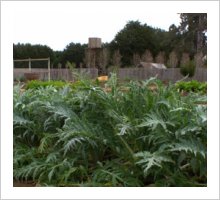Organic Vegetables
The following notes describe the way I grow vegetables here in the garden at Lambley. I have a large area dedicated to vegetables, soft fruit, apples and frost hardy citrus. I grow cut flowers for the house in this part of the garden too.
I want my vegetable garden to be not only productive but also beautiful. The garden is set out in a grid and vegetables are grown in raised beds. I have my own compost heap and much of the compost I make goes onto the vegetable beds. These raised beds are about 90cm wide. I never ever trample on them.
The soil here has, over the past 160 years of cultivation, become fairly to very acid so before I planted anything I put on a good handful of dolomite lime to a square metre. Every year I add a dusting of ground limestone to the beds. It is safe to plant into the garden straight away if using this kind of lime. It's much cheaper to buy large bags from produce stores rather than buy small bags from garden centres.
When first preparing the beds I dig down to about 30cm using a plumbers trenching spade. The soil is turned  over, which helps to bury both weeds and weed seeds, and a couple of inches of compost is added as well as the dolomite or ground limestone and fertiliser (I use Organic Life, a Dynamic Lifter clone, or blood and bone). All these ingredients are worked into the top 8 to 10cm of soil with a rotary hoe although a fork and rake will do the job too. What I’m aiming for at this point is friable soil with a good fine tilth as this will be best for seed planting. I don’t ever work the soil if it is very wet as this can damage the soil structure.
over, which helps to bury both weeds and weed seeds, and a couple of inches of compost is added as well as the dolomite or ground limestone and fertiliser (I use Organic Life, a Dynamic Lifter clone, or blood and bone). All these ingredients are worked into the top 8 to 10cm of soil with a rotary hoe although a fork and rake will do the job too. What I’m aiming for at this point is friable soil with a good fine tilth as this will be best for seed planting. I don’t ever work the soil if it is very wet as this can damage the soil structure.
I always plant in straight lines, using a stringline, as this is the most efficient use of space and it also makes it easier to control weeds. I make a drill along the stringline. If I’m planting fine seed then I make a shallow drill with my finger, if larger seed is being planted I use a trowel to make the drill. A drill basically is a depression into which the seed is planted.
 After the seed is planted then I cover it with fine soil and then generally water with a watering can with a fine rose.
After the seed is planted then I cover it with fine soil and then generally water with a watering can with a fine rose.
I heard a terribly sad story the other day. A vegetable grower, who supplies local farmers markets, planted two thousand open pollinated, “heritage” Brussels sprouts seedlings. After nurturing, watering, weeding and feeding these plants for the best part of eight months his total crop of sprouts was nil. Not one sprout was set.
This is just a more extreme example of what I found when I grew “heritage” seeds. After all the work that a successful vegetable garden requires there should be some reward, there should be some vegetables to harvest. The problem with “heritage” and most open pollinated seed is that no serious seed company is maintaining the strains which then degenerate to such a point that they are at best second rate and at worst, as in the case of Brussels sprouts, useless.

